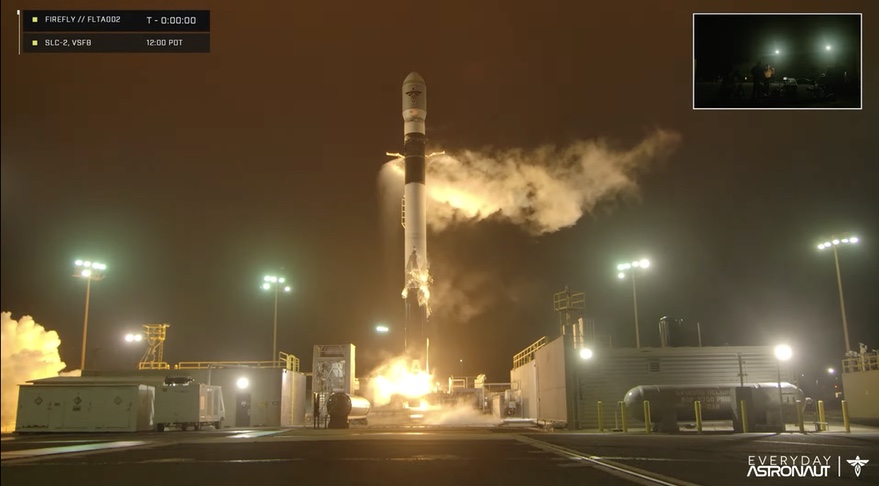KIHEI, Hawaii — Firefly Aerospace’s Alpha launch vehicle reached orbit on its second launch Oct. 1, more than a year after the vehicle’s first launch failed.
The Alpha rocket lifted off from Space Launch Complex 2 at Vandenberg Space Force Base at 3:01 a.m. Eastern. The rocket’s upper stage achieved orbit nearly eight minutes later. After a circularization burn, the upper stage deployed its payloads, and Firefly declared “100% Mission success” about one hour and 45 minutes after liftoff.
Firefly initially attempted to launch Alpha nearly three weeks earlier, on Sept. 11. Controllers halted the countdown one minutes before the scheduled launch, which would have been at the start of a four-hour window. Firefly later said a drop in the supply of helium used to pressurize tanks in the rocket’s second stage prompted the abort, and ultimately scrubbed the launch.
A second launch attempt the next day was postponed by weather, and Firefly then had to wait for improved weather and range availability before making a third attempt Sept. 30. That launch attempt saw the engines briefly ignite as the countdown reached zero, only to shut down. Firefly later said the rocket went into “auto abort” at engine ignition but did not disclose the issue that caused the scrub.
The “To The Black” test flight carried several satellites to be deployed into a 300-kilometer orbit inclined at 137 degrees. The Teachers in Space – Serenity 3U cubesat is designed to collect basic flight data for use by educators. NASA’s TechEdSat-15 3U cubesat includes several technology demonstration payloads, such as an “exo-brake” intended to provide a targeted reentry of the cubesat. A PicoBus deployer carried six PocketQube satellites for AMSAT Spain, Fossa and Libra Space Foundation.

Firefly launched the first Alpha 13 months ago. One of the four Reaver engines in the first stage of the rocket shut down 15 seconds into the flight, although the rocket continued to ascend until it hit maximum dynamic pressure about two minutes later, causing it to tumble. Range safety then detonated the rocket.
The company later determined a faulty electrical connection caused the engine to shut down. The company corrected that problem and made other changes to the manufacturing process, said Peter Schumacher, a partner at majority owner AE Industrial Partners who served as interim chief executive of Firefly in summer. “It’s around ensuring that the second flight, the product that is sitting out there, is the absolute best product that we can produce.”
Schumacher said in July that, if the launch was successful, they would perform one more Alpha launch this year, carrying a set of NASA-sponsored cubesats through a Venture Class Launch Services (VCLS) contract the company won in December 2020.
The company was left off the initial list of companies that received Venture-Class Acquisition of Dedicated and Rideshare (VADR) awards in January for smallsat launches because the company was in the middle of a sale. On Sept. 9, though, NASA announced it added Firefly to the VADR contract, citing the need for a provider capable of launching payloads between 500 and 1,000 kilograms. “Firefly is the only launch vehicle provider in this grouping that has completed development and conducted its first test launch of their Alpha Launch Vehicle,” NASA stated in the procurement filing.
Schumacher said in July that the company is projecting up to six launches in 2023, and is setting up production at its Texas factory to support that launch rate.
The launch came hours after the U.S. Space Force’s Space Systems Command announced it awarded a launch contract to Firefly Aerospace for a space domain awareness mission called Victus Nox, using a spacecraft that will be built by Millennium Space. The announcement did not disclose the value of the launch contract or the estimated launch date.
Victus Nox will be a demonstration of responsive launch, building upon the TacRS-2 mission in June 2021, when Northrop Grumman was given 21 days to integrate and launch a payload on its Pegasus XL rocket.
With Victus Nox, the Space Force is aiming for a 24-hour callup for launch. “What we have challenged that team to do, and what I am seeing them demonstrate the ability to do, is to rapidly respond to a real threat, with an operational capability, using operational crews on operationally relevant timelines,” said Lt. Gen. Michael A. Guetlein, commander of Space Systems Command, in a Sept. 28 speech at the Advanced Maui Optical and Space Surveillance Technologies (AMOS) Conference.
“Within 24 hours, they can bring a satellite launch vehicle together, mate it, encapsulate it, launch it and put it into operations, all within 24 hours, and they’re going to demonstrate that next summer,” he said of the upcoming Victus Nox mission.
Firefly’s Alpha rocket reaches orbit on second launch - SpaceNews
Read More
No comments:
Post a Comment